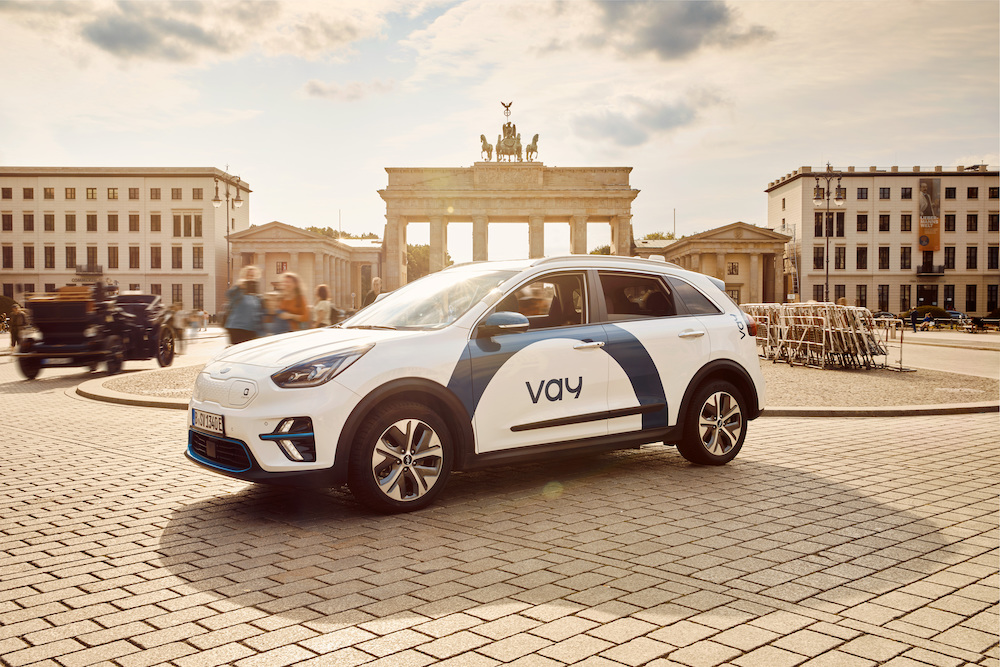
German remote driving startup Vay plans to become the first company with a driverless, certified commercial mobility service operating on public streets in Europe as soon as next year, the company announced Sept. 7.
“Our advanced technology enables a person, the ‘teledriver,’ to remotely drive a vehicle, ‘teledriving,'” Vay co-founder and CEO Thomas von der Ohe said in a statement. “This allows for a safe and timely rollout of driverless mobility services that users and cities trust as a human is still in full control.”
The company’s fleet of vehicles is already operating with safety drivers across all of Berlin today. Recent technological and regulatory advancements will allow Vay to remove the safety driver from its vehicles next year.
Over time, while serving customers, Vay plans to launch autonomous features gradually, based on high-quality teledriving data, starting with the ones that are safe and ready to deploy.
Vay’s system is designed to be safer than conventional driving by controlling the top four causes of fatal urban accidents—speeding, intoxication, distraction, and fatigue. Moreover, when compared with conventional driving from within a car, Vay’s teledrivers have augmented skills, including 360-degree blindspot-free vision.
In addition, Vay’s system is engineered to the highest and latest automotive safety and security standards (ISO26262, ISO21434), and has redundancies throughout its system, including the simultaneous use of multiple cellular networks.
“As our system does not rely on expensive 360-degree LiDAR sensors, and is therefore comparatively inexpensive, our way of rolling out driverless vehicles will not only enable consumers to experience driverless mobility sooner, but also provide a highly scalable solution that can be integrated into every car,” von der Ohe said in a statement. “Having spent six years in Silicon Valley, we are now eager to build a global, first-of-its kind, deep-tech company from Europe.”
Vay will start by offering door-to-door transportation service. People can order a car, which arrives within a few minutes, and then drive themselves to their destination. Upon arrival, they will be able to leave the car without having to park it. This will be offered at a fraction of the cost of an Uber ride, which is why Vay believes its service will be highly competitive with owning a car in urban areas.
In addition to going after urban car ownership, Vay noted its technology can be applied to many other use cases, ranging from ride hailing to ride sharing, from parcel to food delivery, from buses to trucks, and from mining to construction machinery.
The company’s ambition is to not only bring Europe back to the forefront of the race to develop driverless vehicles that will solve many of today’s transportation challenges, but also to create a new job category, the teledriver. This job may have significant benefits over taxi or ride-hailing jobs, as teledrivers can work from the same place every day and are paid a fixed income. Vay believes that teledriving will create more inclusive and gender-balanced employment opportunities due to the additional safety of drivers and customers not having to share the same physical space, especially during the pandemic and at night.
Until the announcement, Berlin-based Vay had been in stealth mode, raising $30 million in Series A funding from leading European venture capital firms such as Atomico, Creandum, LaFamiglia, System.One, Visionaries Club and Signals, as well as Patrick Pichette, the chairman of the board at Twitter and former global CFO at Google; Cristina Stenbeck, a board member of Spotify and chairman of the board at Zalando; and F1 champion Nico Rosberg.

